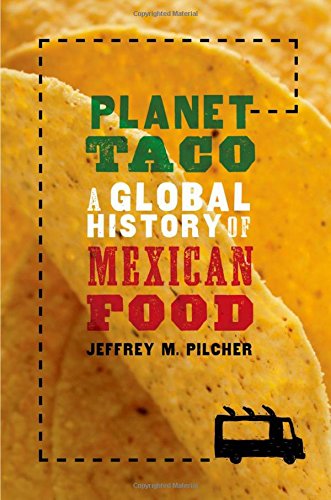Planet Taco: A Global History of Mexican Food / Jeffrey M. Pilcher
| List Price: | |
Our Price: $5.70 | |
|
For Bulk orders
| |
|
Used Book Price: $1.25 | |
| Planet Taco: A Global History of Mexican Food / Jeffrey M. Pilcher | |
| Publisher: Oxford University Press | |
| Availability:Usually ships in 1-2 business days | |
| Sales Rank: 643522 | |
|
Similar Books
The Evolution of the Taco
The Original Taco
The origins of the taco are still disputed. Some attribute it to the ancient Aztecs; others say the term came from Spain. I have found evidence linking the word to the silver mines of eighteenth-century Mexico, where it referred to a stick of dynamite! Whatever the source, the taco shop first became common in working-class barrios of Mexico City at the end of the nineteenth century. The most popular versions then were barbacoa (pit-roasted beef or lamb), carnitas (fried pork), tripitas (tripe and assorted organ meats), and tacos de minero (miner’s tacos), which were filled simply with steamed potatoes and salsa and are now called tacos sudados (sweaty tacos).
The Mexican Taco
During the twentieth century, the taco traveled from Mexico City to the provinces, acquiring new flavors such as cochinito pibil (Yucatecan pit-roasted pork) and carne asada (Sonoran grilled beef). Other versions were invented by new immigrants to Mexico. In the 1960s, the children of Lebanese migrants created tacos al pastor by adapting their parents’ vertical rotisserie of shawarma or gyros (originally called tacos árabes or “Arab tacos”) to tasty Mexican pork. Tacos al pastor were part of a 1960s taco renaissance in trendy Mexico City neighborhoods such as Condesa. Fashionable young people ended a night on the town with tacos al carbon (grilled tacos), which replaced plebeian variety meats with more expensive cuts such as bifstek (beef steak) and chuletas (pork chops). Chefs of the nueva cocina mexicana (nouvelle Mexican cuisine), a gourmet movement that started in the 1980s, created their own tacos. Patricia Quintana, for example, served simple guacamole tacos not on corn tortillas but rather on thin rounds of jícama (an apple-flavored indigenous root). Thus, the Mexican taco continues to evolve.
The Mexican American Taco
In contrast to the Mexican taco, the Americanized taco was supposedly invented in the early 1950s by Glen Bell, the founder of Taco Bell. A hotdog vendor in San Bernardino, California, he claimed inspiration from the McDonald brothers’ fast food hamburger restaurant, which opened there in 1949. Bell began experimenting with tortillas and frying baskets to create the “taco shell,” a U-shaped, pre-fried form that could streamline the production of Mexican food. The problem with this creation myth, whereby Yankee ingenuity transformed a Mexican peasant food, was not only that the Mexican taco was itself a product of modernity. In fact, the original patent for a taco shell had already been awarded to Juvencio Maldonado, a Mexican restaurateur in New York City. Mexican American cookbook author Fabiola Cabeza de Baca Gilbert also gave a recipe for taco shells in the 1940s. Clearly the idea was already present in the Mexican American community. Glen Bell built a taco empire not on modern technology—the McDonaldization myth—but rather by selling exotic foods to people who may not have wanted to visit Mexican neighborhoods. Instead of the fast food taco, we should call it the Mexican American taco as a tribute to the hard-working cooks who adapted the Mexican taco to their American lives.
The Multiethnic Taco
Some of the most popular tacos in Southern California today are not Mexican but Korean. Roy Choi’s Kogi Korean BBQ taco trucks have used Twitter to attract long lines of people hungry for short rib tacos and kimchi quesadillas. Choi and other new immigrants chose tacos in order to “Americanize” their cooking, and they were not the first to create multiethnic tacos. The Kosher Burrito was founded in Los Angeles in 1946 by a Jewish man who married a Sonoran woman; it sells pastrami tacos and burritos as a kosher alternative to pork carnitas and chorizo. Taco shops also opened in African American neighborhoods of Watts and South Central Los Angeles in the 1950s, often with catchy names such as Taco Th’ Town. One such place served blacked-eyed peas in a taco shell as “African Tacos.” More recently, Midwestern Americans have welcomed the taco to one of their most beloved institutions, the state fair, where you can now find deep-fried tacos on a stick.
The Scandinavian Taco
The taco is a national dish not only in Mexico and the United States but also in Norway. The globalization of the taco was started in the 1960s by Americans, particularly military personnel stationed abroad and surfers looking for the perfect wave. Having eaten Mexican American food in the Southwest, they could not imagine life without it. But as a result, it was Tex-Mex and Cal-Mex versions that set global stereotypes. In Norway, Fredagstacoen (Friday tacos) have become a domestic ritual, stuffed with the usual Cal-Mex combination of ground beef, lettuce, tomato, and mild salsa as well as such novelties as white cheese, sour cream, cucumber, and canned corn. Mexican travelers are understandably annoyed at such liberties, but they can take heart from the recent spread of tacos al pastor around the world. The taco shell was merely the first course, whetting a global appetite for Mexico’s regional cuisines.
Now you can buy Books online in USA,UK, India and more than 100 countries.
*Terms and Conditions apply
Disclaimer: All product data on this page belongs to
 .
.No guarantees are made as to accuracy of prices and information.










